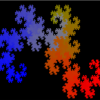Recently i've been messing around with interpolation methods on scalar fields because im trying to make the scalar field of discrete points, continuous.
I think I understand how bi-linear interpolation works. To my knowledge,In order to interpolate a value(using bilinear interpolation) you have to do three "lerps" using four discrete neighbor points on the field. But when it comes to higher order interpolation methods, I'm lost. I know how to use quadratic interpolation to interpolate a value using 3 discrete points on a function. How would I use quadratic interpolation on a scalar field?



